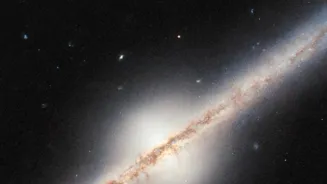Unveiling the Cosmic Microwave Background: Peek into the Universe's Genesis. Dive into the Big Bang's echo and unravel cosmic mysteries
Imagine peering back in time, not just years or decades, but almost
13.8 billion years, right to the very infancy of the universe. This is precisely what scientists are doing when they study the Cosmic Microwave Background (CMB), the faint afterglow of the Big Bang.
This residual radiation, permeating the entire cosmos, offers a treasure trove of information about the universe's origins, its composition, and its ultimate fate. Understanding the CMB is akin to deciphering the universe's DNA, providing clues to some of the most profound mysteries of existence.
Indian scientists and researchers are playing a crucial role in unraveling these cosmic secrets, contributing to global efforts in this fascinating field.
Early universe's opaque fog clears during recombination, revealing CMB snapshot
The CMB wasn't always detectable. In the early universe, it was incredibly hot and dense, akin to an opaque fog. Light couldn't travel freely; instead, it was constantly scattered by plasma of protons and electrons.
As the universe expanded and cooled, this plasma eventually recombined into neutral hydrogen, rendering the universe transparent. This momentous event, known as recombination, occurred roughly 380,000 years after the Big Bang.
It was then that the photons of the CMB could finally stream across the universe, carrying with them a snapshot of the universe at that early epoch. It’s like looking at a baby picture of the cosmos – wrinkled, almost unrecognizable, but full of potential.
The temperature of this afterglow is incredibly uniform, only about 2.725 degrees above absolute zero.
Faint radiation from Big Bang discovered by Penzias and Wilson
This faint background radiation was accidentally discovered in 1965 by Arno Penzias and Robert Wilson, two scientists at Bell Labs. They were trying to troubleshoot a noisy microwave antenna when they detected a persistent, ubiquitous signal that couldn't be attributed to any known source.
That constant noise, it turned out, was the echo of the Big Bang. The discovery confirmed the Big Bang theory and earned Penzias and Wilson the Nobel Prize in Physics.
If you were to tune your old analog television to a channel with no signal, some of the static you see is actually contributed to by photons from the CMB. While a small percentage, it's still a connection to the very beginning.
The CMB's temperature fluctuations reveal early universe secrets
The real magic of the CMB lies in its tiny temperature fluctuations, or anisotropies. These minute variations, only a few parts in a million, are like fingerprints from the early universe.
Cosmologists believe that these tiny density fluctuations in the early universe acted as seeds for the formation of all the structures we see today, from galaxies and galaxy clusters to stars and planets.
By carefully studying these anisotropies, scientists can learn about the density of matter in the early universe, the geometry of space-time, and the composition of the universe. These differences are not noise, but valuable data points, revealing nuances about the early universe.
Space missions map CMB, unveil universe's secrets
Several space missions, like the Cosmic Background Explorer (COBE), the Wilkinson Microwave Anisotropy Probe (WMAP), and the Planck satellite, have meticulously mapped the CMB with increasing precision.
These missions have provided detailed images of the CMB, showing the pattern of temperature fluctuations across the sky. Analysis of these maps has revealed a wealth of information about the universe's age, shape, and composition.
For instance, Planck's data has shown that the universe is made up of about 5% ordinary matter, 27% dark matter, and 68% dark energy. These missions are like time machines.
Indian scientists lead CMB research, using GMRT and global data to study universe expansion
Indian scientists are actively involved in CMB research through various projects and collaborations.
For example, the Giant Metrewave Radio Telescope (GMRT) near Pune has been used to study the Sunyaev-Zel'dovich effect, a phenomenon where CMB photons are scattered by hot gas in galaxy clusters, providing information about these clusters and the expansion of the universe.
Additionally, Indian researchers are involved in analyzing data from international CMB experiments and developing theoretical models to understand the origin and evolution of the CMB. Several research university students are also taking up cosmology for their career.








